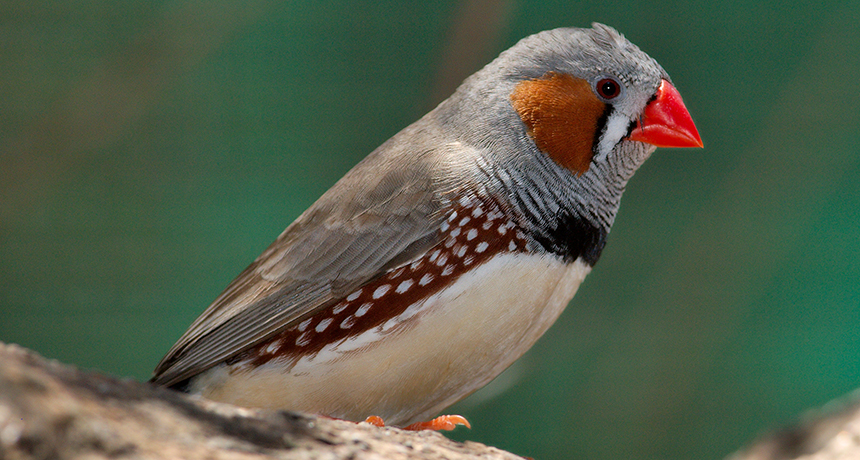Zebra finches can ‘drink’ water from their own fat
New research shows that during a drought, these birds can quench thirst from this non-dietary source

Thirsty zebra finches can dodge dehydration during a drought by breaking down body fat, a new study shows.
Peripitus/Wikimedia Commons (CC BY-SA 3.0)
By Susan Milius
Birds need water to survive. When there isn’t any around, some can find a clever way to reuse water that is already in their bodies. Thirsty zebra finches, for instance, may tap their body fat.
Researchers in Poland reported this new finding September 1 in the Journal of Experimental Biology.
When ultra-thirsty, birds sometimes will break down muscle or other proteins in their bodies to get access to life-sustaining moisture. But birds need muscle for flying and fororgans such as the heart. So breaking down too much protein could do them more harm than good.
Zebra finches (Taeniopygia guttata) are native to central Australia. It’s a region that can be very dry. And these birds are the first to be clearly shown to use their own fat, not protein, to get through a day without food or water, says Ulf Bauchinger. He works at Jagiellonian University in Kraków, Poland. As an evolutionary physiologist, he studies how the bodies of animals and plants change over time to adapt to their environments.
Scientists have known that animals — including people — free up some water as their bodies turn food (fat, protein or carbohydrates) into fuel. The challenge in birds has been for scientists to figure out how to probe whether their bodies might free up water from stored energy — body fat.
So Bauchinger, Joanna Rutkowska and other scientists studied zebra finches in their lab. They restricted the finches’ food and/or water for one day. Twelve got food only. Another dozen got water only. A final dozen got neither. Then the researchers measured the animals to see how they had coped on these diets or a day of starvation.
All of the birds stayed well-hydrated during this “drought” day — even those who got no food or drinking water. But this last dozen lost more body fat than did those allowed to drink but not eat. By day’s end, the dry birds had 42 percent less fat than the birds given water. Both groups of birds lost about the same amount of lean tissue. This included protein-rich muscle.
Zebra finches weigh on average just 13.5 grams (0.5 ounce). During the “drought” day, each finch produced about 0.44 gram of water by breaking down body fat. Liberating this much water using protein only would require one-third of their flight muscles or an amount three times the mass of their hearts.
Alexander Gerson is a biologist at the University of Massachusetts Amherst. He calls the new findings “exciting.” Gerson is interested in how birds cope with extreme environmental challenges. Among the toughest is flying several thousand kilometers across the Sahara Desert in Africa, for example, as some birds migrate to new seasonal homes.
To study this, Gerson got birds to fly in wind tunnels. This mimicked their long flights in the wild. Migratory birds can get energy by burning fat. That’s what they use to power their flight. But in this test, they also broke down protein.
Gerson also has studied birds that were not doing extreme athletics. Here, he focused on sparrows not exercising in a wind tunnel. But even these birds, he found, showed signs that might be breaking down protein when they urgently need water.
Unlike house sparrows, wild zebra finches naturally live in dry places such as Australia. Gerson says that how dry a bird’s natural habitat is might affect whether it uses just fat or breaks down a lot of protein to liberate needed water. He also points out that his testing methods might have affected his results. The finches were truly fasting — starving — in the Polish experiment. Gerson’s birds, in contrast, ate a bit of breakfast before they were tested.
Rutkowska suspects other super-thirsty bird species may respond to water shortages as zebra finches do, by focusing on fat breakdown.







